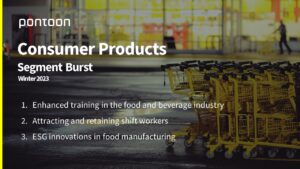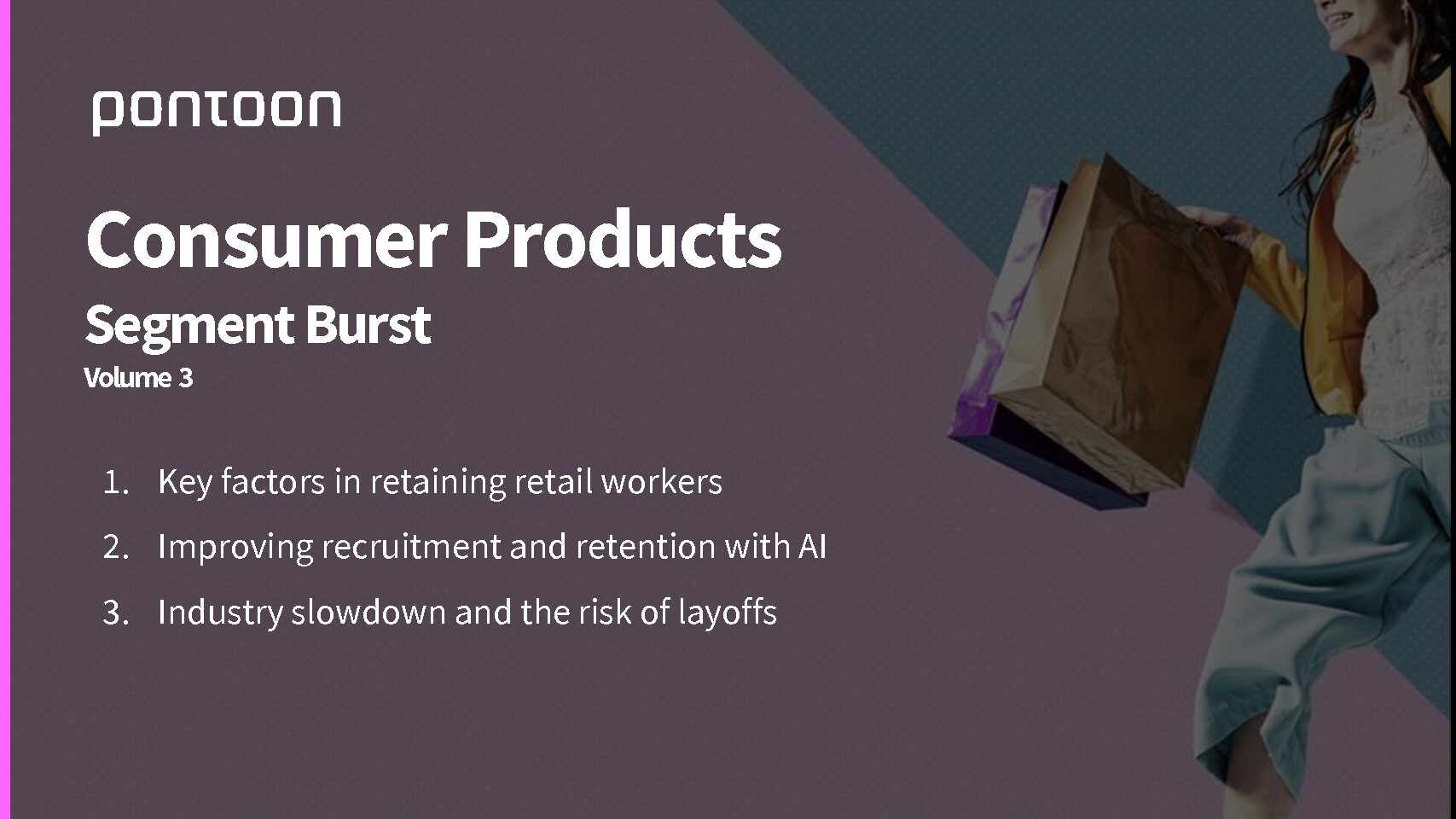Consumer Products Segment Burst: Winter 2023
Research
.
In the new volume of Consumer Products Segment Burst we explore the most recent trends in the food manufacturing industry.
-
How enhanced training opportunities can improve talent attraction in the food and beverage industry?
-
What can food manufacturing companies do to effectively attract and retain shift workers?
-
What impact will ESG innovations have on hiring strategies in food manufacturing?
Read on to find out.
Enhanced training in the food and beverage industry
Enhanced training, especially when conducted with the help of affiliate organisations, is an excellent strategy for talent attraction in the food manufacturing industry.
A recent example of a company that has successfully fused talent acquisition with training is Kepak. This Irish manufacturing company specialising in meat craft became the first business in the UK to grant interviews and free training places for candidates who finished industry-specific courses developed by the National Skills Academy for Food and Drink.
NSAFD is a non-profit organisation that helps UK manufacturers upskill their workers and attract new generations of talent. NSAFD maximises the value of apprenticeship programmes and develops skills solutions driven by data-based insights into the food and drink sector.
To mitigate the risks of talent shortages, industry leaders in the food and beverage industry should take action to change the outdated perception of food manufacturing. Studies confirm that while 58% of US surveyed respondents are convinced that manufacturing jobs offer limited career options, a whopping 80% would be interested in joining the sector’s workforce if training and clear career paths were offered.
By seeking out strategic partners and offering free training initiatives to prospective candidates, food manufacturing companies can position themselves as attractive employers that care about their workers’ skills development.
Attracting and retaining shift workers
Food and beverage sector employees often face the unique challenge of working long shifts – including at night.
There is no doubt that night shifts take a toll on workers’ health and work-life balance. Recent scientific findings confirm that the human body does not adapt to night work even over long periods of time. Night-shift workers have less than half the median sleep regularity and sleep quality of day-shift workers and 20% of night workers cannot adjust their sleep patterns during their free time.
Given that removing night shifts is not feasible when operating 24/7, what can companies do to more effectively attract and retain shift workers?
- Provide more transparency around shift work in job descriptions. Describing available shift work patterns in job ads, sharing employee stories about their shift work experiences, and distributing employee guidelines even at the application stage would help potential candidates to make more informed career choices, thus allowing companies to retain talent for longer. Allowing workers to feel more in control of their shift work patterns can increase job satisfaction and engagement at work.
- Leverage specialised software for shift scheduling. Using the right tech and consultancy can help with schedule creation and worker monitoring. With this support, manufacturing firms can drive the delicate balance between predictability and flexibility craved by the workers in the sector.
- Display greater awareness around shift work. To be the employer of choice, companies must be aware of all issues related to shift work, including health, safety, and wellbeing hazards. They should take a proactive stance in securing a healthy workforce for the ultimate success of their business.
ESG innovations in food manufacturing
Food manufacturers are particularly vulnerable to climate change – while simultaneously being responsible for almost 20% of global carbon emissions.
To reduce their carbon footprint, companies are investing in new technologies and innovations. One example is vertical farming, a type of indoor agriculture based on hydroponic systems, LED lighting, and vertical stacking of plant beds. As the example of Canadian vertical farms demonstrates, growing food indoors takes less time than open-field farming – all that while significantly saving water and eliminating the need for pesticides and herbicides. However, vertical farms use nine times more energy per pound of produced food than greenhouse farms, thus driving up costs and negative environmental impact.
Innovations in sustainable farming are not yet ideal. However, they are clearly beneficial for the industry’s development – in recent years, improvements in agricultural technology, biotechnology, and intelligent manufacturing have helped to increase agricultural production capacity and the utilisation rate of land resources.
Additionally, a recent joint report from McKinsey and Nielsen confirms that ESG is good for business – 60% of US consumers say they are willing to pay more for a product with sustainable packaging. More importantly, the consumers are backing their statements with purchasing behaviour. In the last five years, products with ESG-related claims accounted for 56% of all growth.
New technologies hold promise for combatting climate change and volatile food supply chains but require ongoing improvement. To deliver on their environmental promise in a meaningful way, food manufacturing companies should invest in scientific and technological talent that can drive positive change.
Hiring for ESG needs
As Frederik Otto, Pontoon’s Global Head of Client ESG Impact, observes “most organisations do not yet sufficiently recognise the human capital aspect of their ESG strategies.”
When hiring for their ESG needs, food manufacturing companies should thus ask themselves:
- Do HR functions understand the milestones of the ESG strategy?
- Is the organisation pre-, re-, and upskilling employees for future endeavours?
- Is talent actively pipelined to fulfill commitments to stakeholders such as net-zero targets?
Read Frederik’s thought leadership article to learn more.
Related Post
In the third volume of Consumer Products and Retail Segment Burst we explore the most recent trends in the sector.
What are the key factors in retaining retail workers?
How ...





